The Ferula communis came to fruition last year after two seasons in the ground readying themselves. They bolted skyward like Roman candles and we stood in their shadow to wonder at the enormous surge of energy, summoned from the deep and tracking the awakening spring. The expenditure of those that flowered last year sees them resting now, hunkering down to nothing but foliage to build their reserves. It is too early to say how many cycles they can sustain here before they give up and make way for a new generation, but for now I am pleased that they have staggered themselves and will ensure I do not go without a spring in their company.
As if the group in the herb garden had been in silent conversation, this year’s flowering plants have distributed themselves rather nicely, throwing four fresh spikes to articulate an easy distribution. New leaves were already pushing from dormancy in November and they sailed through the wet winter with our slopes draining easily. Mounding slowly through the cold season and pushing against the stillness elsewhere, the netted foliage remained untouched, easily coping with wind and bowing gently but recovering after the frost. They kept their fine structure, the snowless winter sparing them its potentially damaging weight. So, by late February, we were already parting the growth to check for the fattened, flowering stems which were already preparing to move with the lengthening days.
It is easy to spend time with the giant fennels, for their rapidly moving architecture has an animalistic quality. Armature and sheath unfolding, tendoned limbs extending as they move always upwards, the day they peak is the day you see the beginning of summer. Buttercups rising above the grass. The first poppies and leaves flushed on the trees. We are lucky to have the room here for several colonies to test different varieties and in differing situations. We are bathed throughout the day in sunshine, for they would not do well without it.
The Tangier fennel, Ferula tingitana ‘Cedric Morris’, is the first into flower and grows against the espalier wall that it shares with the pears. They are taking a fallow year this year after flowering plentifully last, but their distinctive, shiny foliage is good even when they are taking some downtime. Although the giant fennels are said to be short-lived as a tribe, they are proving to be reliable here where they are never overshadowed in a planting and this seems to be a general rule for their well-being. The ‘Cedric Morris’ came with me as seed from the Peckham garden and establishing seedlings when they are young is the best way to ensure happiness. I keep a few generations on the go in the cold frame so as to always have a spare or two to keep an age-range but, as with most umbellifers, their roots dive deep to provide the foundations for their great bolt of flower, so they should never be allowed to become pot-bound before planting out.

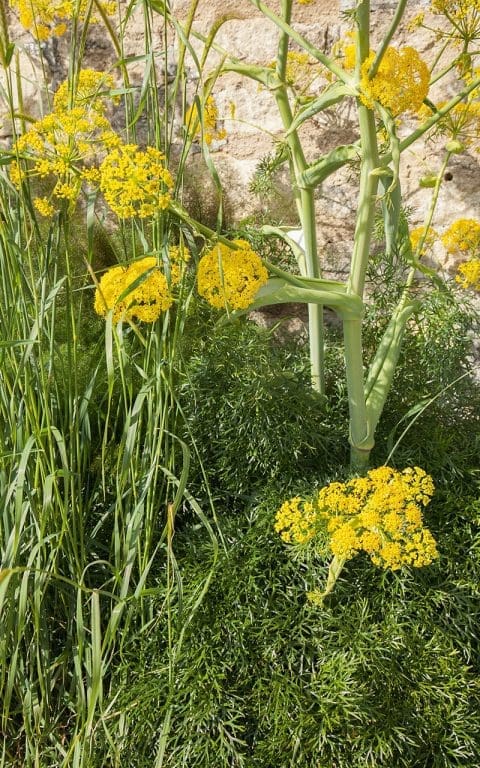
I have several forms of Ferula communis, the larger-growing cousin and close relative to the Tangier fennel, all of which were given to me by Fergus Garrett at Great Dixter. Immediately in front of the house and in the yard below it we have Ferula communis subsp. glauca. This is the most elegant of all, in my opinion, for its slender limbs and burnished dark green leaf. I have planted it amongst the rockscape of the re-imagined Delos Garden I recently designed at Sissinghurst. We sourced the plants from Olivier Filippi in southern France and, although young when we planted them in the autumn, I could immediately see that his form of F. c. subsp. glauca was distinct from the Dixter form. Finer, more wiry and exhibiting a variable trait, which is common in a plant that has such a wide distribution across southern Europe and into Eurasia.
The straight Ferula communis we have growing in the herb garden (main image) has paler, more netted foliage. It is the largest growing, the flowering stems being as thick as my wrist and rising to three metres tall over the course of a month. Despite their open position here on our hillside, they still search for the light and the stems each chart the sun’s movement due south to show you their desire. After a heavy West Country drizzle last week we woke to find the tallest two having toppled. Grown too fast and furious on our fertile ground, they have probably just been a little spoiled and lacked the stamina of the plants that find their way into crevices on the rocky slopes of their homelands. We spent an hour before breakfast carefully staking and hope that, as the acid-yellow flowers go on to produce the weight of paddle-shaped seed, our endeavours will not be further challenged.
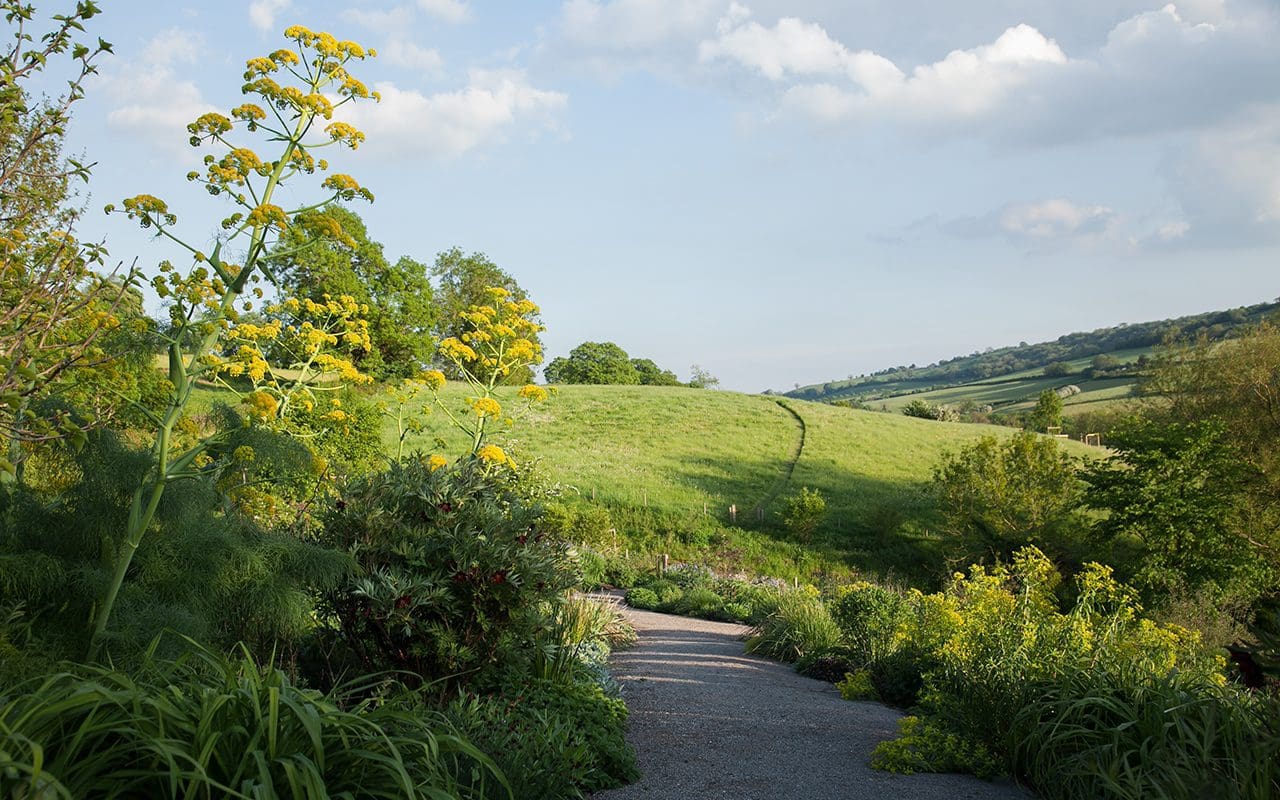
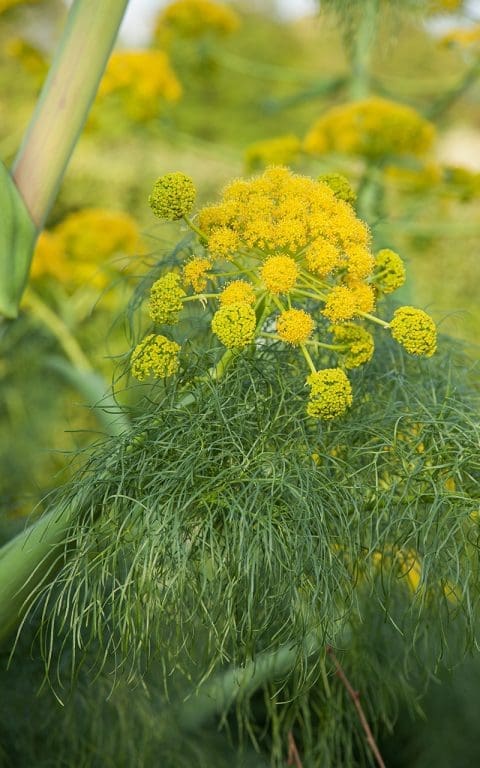
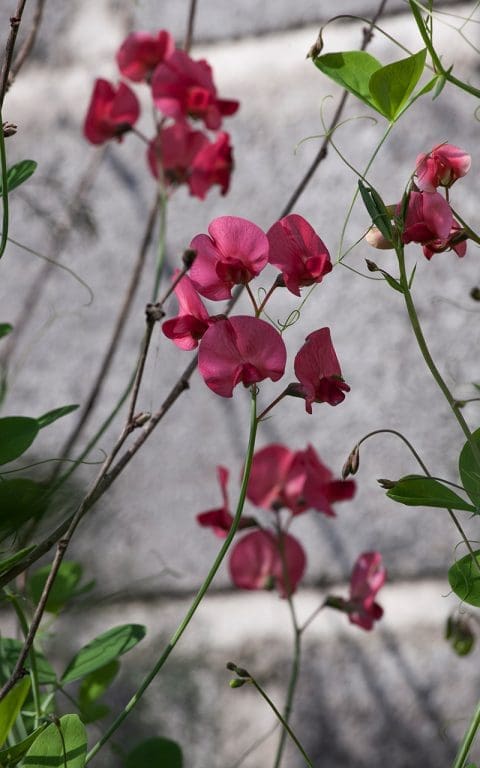
In the main garden we have a possible cross between Ferula communis and F. tingitana. Passed to me in a brown paper bag by Michael Wachter, one of the Great Dixter gardeners, with words on the bag stating “From Fergus. F. communis. Tingitana blood”. It has risen to flower this year for the first time. The foliage is more feathery again that F. communis and consistently so across all the seedlings. I have planted it with scarlet oriental poppies pushing up through the foliage to remind me of the first time I ever saw giant fennel in the Golan Heights with scarlet Anemone pavonina. Planted on the south side of the fennel foliage so that they do not get overshadowed too early in the season, I have added an early flowering pea, Lathyrus rotundifolia. With Turkish origins (which means that it is also an early riser) I plan for the pea to rise up into the net of the fennel foliage and then go on to scale the lofty tower of flower. The pea, I am hoping, will climb tall enough for the soft, carmine flower to mingle with the sharp brilliance of the fennel in flower during May and June. Both the pea and the fennel will be over and gone to seed by the time the rest of the garden has taken over in July. The pea rupturing its drying pods on a hot day with a distinctive crack and patter of far flung seed. The fennel foliage withered, to leave nothing but the architecture of the flowering stem and seed held high to be caught in late summer by wind and distributed. You have to be ready for the hole when this happens and plan for it not being a gaping one. We have Salvia ‘Jezebel’ planted in front to make late cover for the small inconvenience of bare ankles.
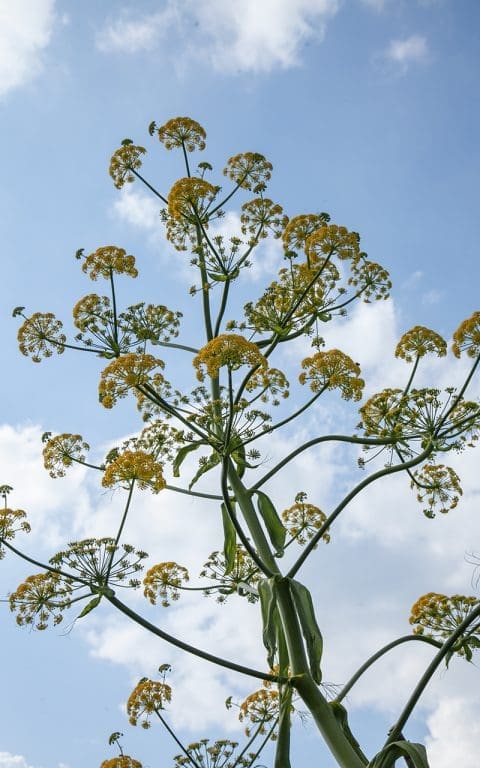
Words: Dan Pearson | Photographs: Huw Morgan
Published 9 May 2020
The various utensils, paper bags and home-made envelopes that have been accumulating all summer were grouped together recently for examination. I find it hard to resist when seed is there for the taking and it is something that I want or could do with more of. If I am lucky and have had a pen handy, the makeshift envelopes are scrawled with notes to make identification easy. The unmarked vessels might need a rattle and a closer look to remind me, but the excitement of a haul usually burns the find into the memory, as long as I act before winter blurs the clarity of this past growing season.
Fortuitously, autumn is the best time to sow the hardy plants and I would rather have them in the cold frame, labelled up and ready to go than degrading and waiting until the spring. In the wild, seed will start its cycle within the same growing season, so emulating the natural rhythm makes perfect sense. Most seed will now sit through the winter to have dormancy triggered by the stratification of frost, but some will seize the damp and comparative mild of autumn to germinate before winter and begin their grip on life.
The giant fennel are a good example. In the Mediterranean and Middle East where they are dependent upon the winter rainfall for growth, summer-strewn seed is now germinating with the first rains. My own sowings from August have already produced their second true leaf and are now potted on in long toms so that they can continue to establish their strong tap roots in the mild periods ahead of us. The winter green of Ferula communis (main image) is remarkable for this late season regeneration, gathering strength when it isn’t too cold and pushing against the general retreat elsewhere.
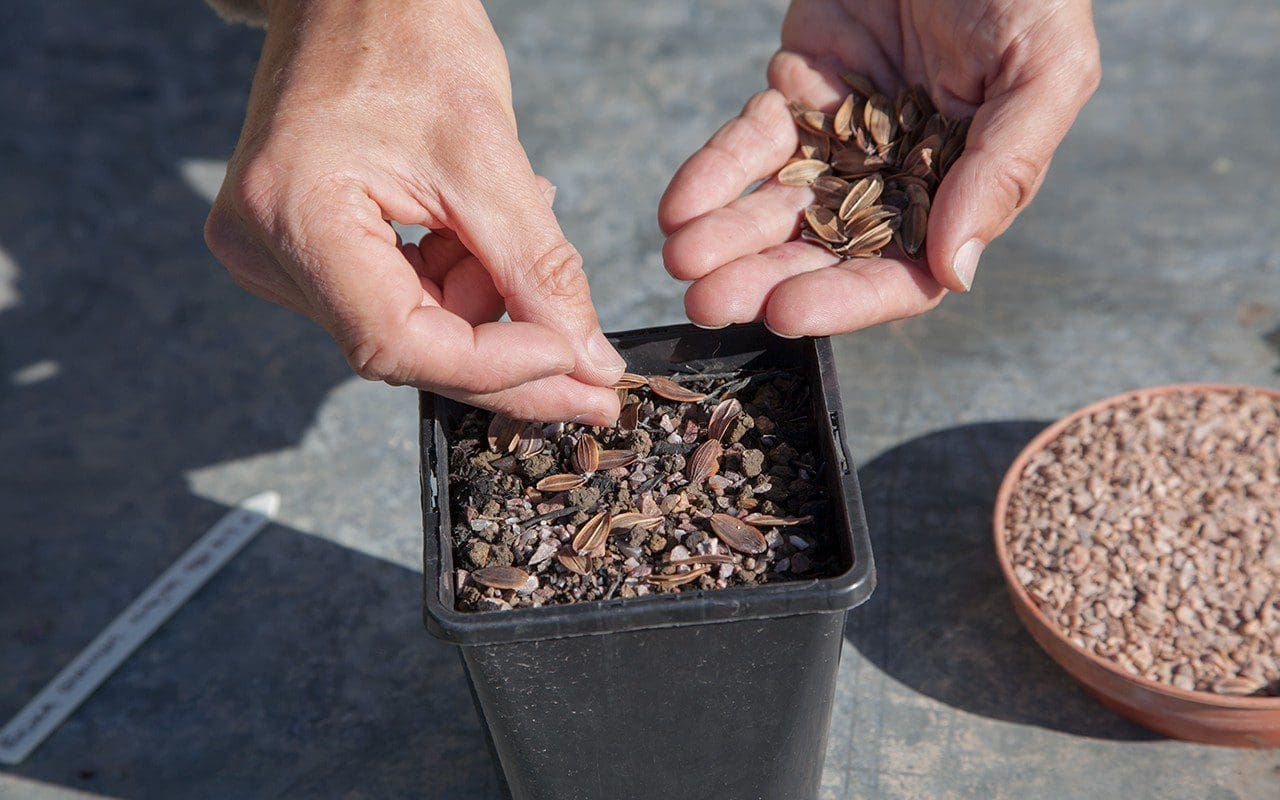 Sowing seed of Ferula communis in Autumn
Sowing seed of Ferula communis in Autumn
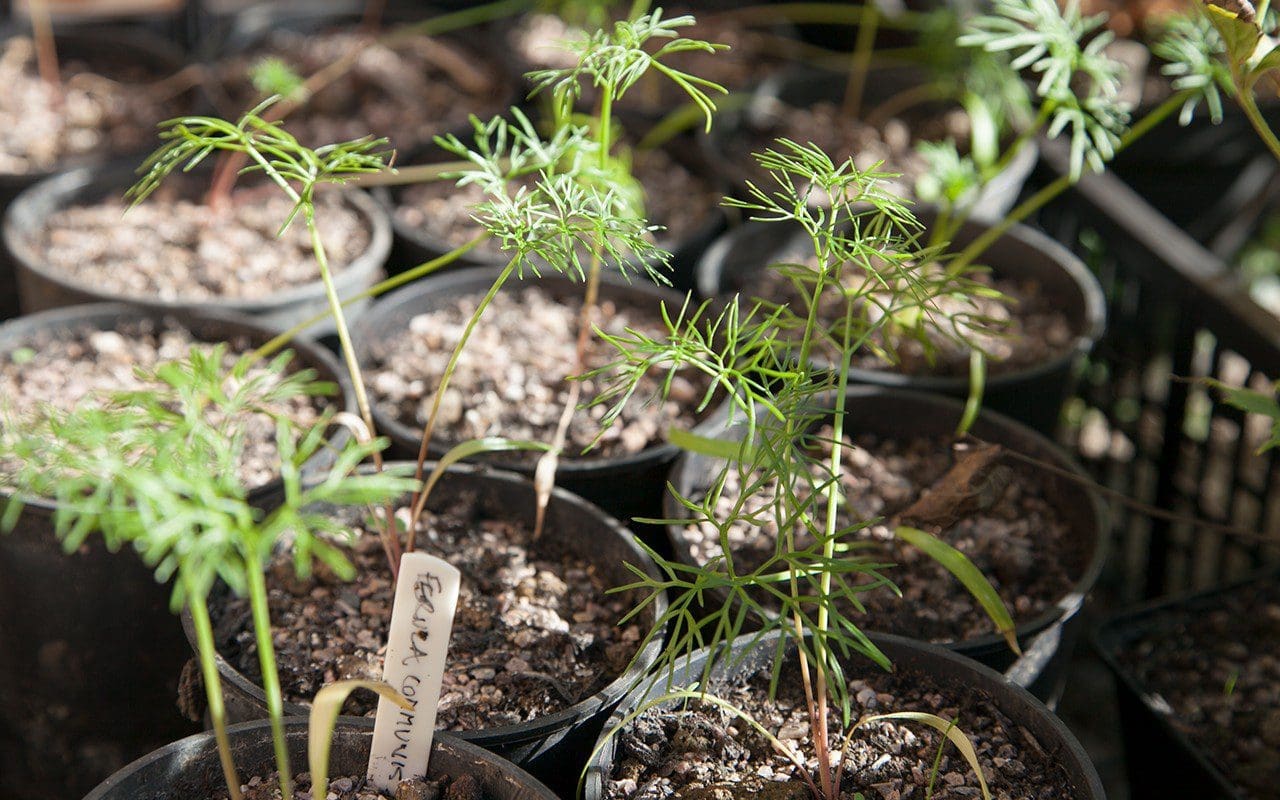 Seedlings of August’s sowing of Ferula communis in the cold frame
Seedlings of August’s sowing of Ferula communis in the cold frame
I first saw giant fennel in my early twenties when I was a student at the Jerusalem Botanical Gardens. Michael Avishai, the Director, had driven me to the Golan Heights to see them in the minefields where they grew freely and undisturbed. We stood at the roadside, taking heed of the sign saying ‘DANGER MINES! Go no further.’ Mile upon mile of cordoned-off ground, back-dropped by the mountains of Syria, was populated by a legion of uprights which bolted skyward in a scoring of perfect verticals. You understood why the Romans had used them as ferules, their stems making a lightweight measuring rod. Amongst their feathery mounds of basal foliage, a flood of acid-green euphorbia and scarlet anemone scattered the rocky ground between them.
You need open ground and the room to be able to let giant fennel have its reign in the garden. Whilst the plants are gathering strength, the early foliage needs the air and light they are accustomed to. Once they have bolted all their energy into the lofty flower stem, the foliage withers to leave a space, so you need to plan for a companion such as Ballota pseudodictamnus that can take a little early shade, but will cover for the gap in high summer.
I first flowered Ferula tingitana ‘Cedric Morris’ in my garden in Peckham and brought seed from there to here. It is the first of several giant fennels to have flowered here and did so in its third year after planting out. This lustrous form of the Tangier fennel is spectacular for its early growth, which is as shiny as patent leather, but finely-cut like lace. The flowering stem, which is shorter than F. communis, which can grow to 3 metres, holds an inflorescence that is just as flamboyant, despite reaching just half that height. My plants originally came from Beth Chatto where it appears in her gravel garden and this is how they like to live, with guaranteed good drainage in winter. I mean to ask if she was given the plant by the great man himself, for I am amassing quite a number of his selections and enjoy the connection of these horticultural hand-me-downs.
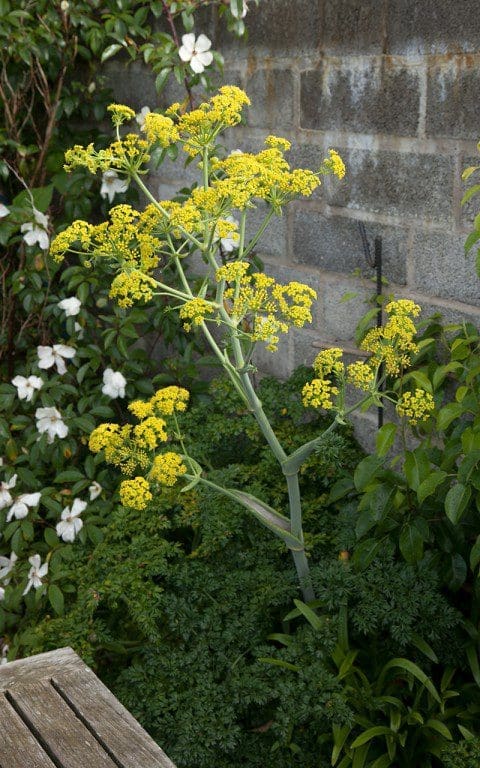 Ferula tingitana ‘Cedric Morris’ flowering in late May
Ferula tingitana ‘Cedric Morris’ flowering in late May
Coincidentally, I was given a brown paper bag with ‘Ferula tingitana blood’ scrawled on it by one of the gardeners from Great Dixter at a lecture that I gave for the Beth Chatto Education Trust earlier this summer. It is one of several ferula that Fergus Garret has passed on to me over the years. He too is under their spell and has given me seed of several of his wild collections from his homeland in Turkey. Once, when I asked him what the mother plant was like, he said, ‘No idea. It’s bound to be good though. Try it !’. And with giant fennels I am very happy to take him on trust.
Fergus uses them as punctuation marks in the garden where they bolt above moon daisies and rear over the hedges like giraffes. They have started to hybridise there and, when they are established enough to plant out next spring, the ‘tingitana blood’ seedlings are destined for my new planting. The secret to growing them successfully is to plant them out before the long tap roots wind around the pot for, to support the huge flowering stem, they need their purchase deep in the ground like a skyscraper needs its footings.
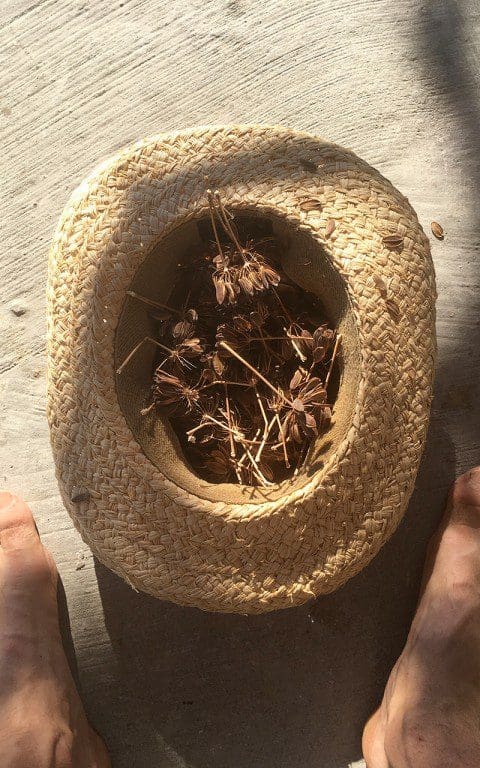 A hatful Ferula communis seed gathered in Greece
A hatful Ferula communis seed gathered in Greece
This summer, whilst on holiday in the Dodecanese, I collected a hatful of Ferula communis that had flowered beside the road and somehow escaped the ravages of the island goats. Though I had not seen it in flower, it was impossible to pass it by and the thought of it reappearing as a memory in the garden here will allow me to relive this find when it comes to flower. The seed left after my own sowing is now sitting in a bag waiting to go to Fergus, with a scrawled message of well wishes and the happy thought that they will soon be on their way to another good home.
Words: Dan Pearson / Photographs: Huw Morgan & Dan Pearson
Published 7 October 2017
We are sorry but the page you are looking for does not exist. You could return to the homepage